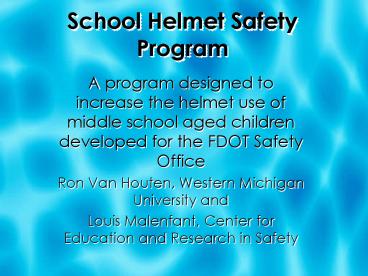School Helmet Safety Program - PowerPoint PPT Presentation
1 / 19
Title:
School Helmet Safety Program
Description:
Some Facts. Helmets are 85% effective in preventing ... movie on how to fit a bicycle helmet ... without helmets, gives helmets out and helps fit helmets ... – PowerPoint PPT presentation
Number of Views:56
Avg rating:3.0/5.0
Title: School Helmet Safety Program
1
School Helmet Safety Program
- A program designed to increase the helmet use of
middle school aged children developed for the
FDOT Safety Office - Ron Van Houten, Western Michigan University and
- Louis Malenfant, Center for Education and
Research in Safety
2
Safety is Important
- Per capita bicycle deaths in Florida are more
than twice the national average - Florida leads the nation in bicycle fatalities
- Middle School Aged Children have the highest rate
of fatal and injury crashes
3
Some Facts
- Helmets are 85 effective in preventing head
injuries - At some middle schools in Florida we have found
as few as 3 of the children riding to school
wear a helmet - We often see children with bikes wearing the
helmet on the handle bars - When helmets are worn they are frequently
unbuckled or the straps are very loose.
4
The School Bicycle Safety Program
- Students selected to participate as school
Bicycle Safety Patrol are trained by the school
SRO how to observe and identify key safety
behaviors of student bicyclists as they travel to
and from school.
5
The ProgramStep 1 Measure Helmet Use
- Grade 8 students are enlisted to make up the
school bicycle helmet safety patrol. - Students are taught to score helmet use and
whether the helmets are worn correctly. - Students score behavior at the end of the school
day. - SRO assigns students days to score and meets with
them periodically to keep them motivated.
6
Students are given special shirts
7
Students are give easy to use sheets
8
The SRO meets with student patrol
9
Students who record data are given certificate
for Community Service hours at the end of the year
10
How Well Do Children Measure Behavior
- They were highly accurate in measuring helmet use
and whether the helmet was correctly worn - Accuracy was determined by having two youths
measure the behavior together and calculating the
percentage of agreement between the two. - Reliability was also computed between the
students and research assistants.
11
Step 2- Program Kick Off Presentation on Bicycle
Safety
- The School Resource Officer (SRO) initiates the
program at an assembly by making a presentation
on bicycle safety - Showing a short movie on how to fit a bicycle
helmet - Moderating a discussion on bicycle safety, which
includes setting target goals - The SRO also identifies students without helmets,
gives helmets out and helps fit helmets - The SRO explains the program
12
Explains Posted Feedback
13
Step 3 - Feedback on Progress
- Following the presentation by the SRO the school
bicycle safety patrol (students that record data)
post the average daily student performance for
each target behavior on a large chart inside the
school entrance. - A weekly announcement on Monday morning provides
feedback on the level of each safety behaviors
attained the previous week, praise improvements,
and prompt behaviors for the following week (SRO
or students make announcements).
14
Posted in Locations that are vandal proof and in
common viewBefore After
15
Step 4 Shared Rewards
- Shared rewards for group performance tend to
facilitate group cohesiveness among members of
the group. - Rewards will include praise from staff and the
SRO and an ice cream party or a pizza party at
the end of the project with donated prizes and a
draw for a bicycle.
16
Results
- The program produced a large increase in helmet
use and correct helmet use in all three schools - The program produced the largest increase in the
two schools with a history of helmet enforcement - Helmet enforcement alone did not get helmet use
into the target area - The program without enforcement (one school) was
effective but did not get helmet use into the
target area
17
(No Transcript)
18
(No Transcript)
19
Other results
- Probe data taken by research assistants showed
that helmet use also increased in the morning
even though data were not taken in the AM - Probe data showed that students did not take
their helmet off a quarter mile to a half mile
from the school - The results persisted after the party was over































